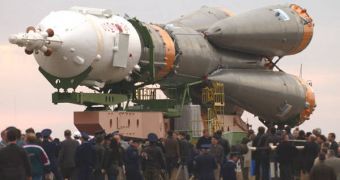Yesterday, a high-ranking official from the Russian Federal space agency RosCosmos announced the agency came to an agreement with NASA, concerning the price that the American agency would have to pay in order to have its astronauts ferried to orbit and to the International Space Station between 2010 and 2015. The source said that a single seat on the Russian-built Soyuz spacecraft would cost as much as $51 million, which meant that NASA would have to pay twice that much if it wanted two of its astronauts to be sent to the ISS.
Over the last few months, the American agency announced that it planned to buy as much as 24 seats on the capsules, over five years. Starting September 2010, NASA could potentially retire its three-shuttle fleet, and will accelerate its efforts to complete the Constellation Project on schedule, with the first ARES I-X test flight scheduled for 2015. By 2018, it will take astronauts back on the ISS and to orbit on a regular basis, while, until 2020, as part of the Project, made up of the ARES rocket array, the Orion Crew Exploration Vehicle and the Altair Lunar Lander, NASA intends to return people to the Moon.
“We have reached an agreement with NASA to increase the price for a single seat on Soyuz space craft for US astronauts traveling to the ISS to $51 million, with adjustment for inflation,” RosCosmos' Manned Flight Programs Director Alexei Krasnov told in an official statement. Talks between the two national agencies resumed in October 2005, after the Congress amended the Iran Nonproliferation Act, which made it illegal for the US to engage in talks with countries that collaborated with Iran on nuclear weapons.
The Russian Federation was such a country, and the cooperation in the field of nuclear energy was perceived as a threat by the United States. Iran has always argued that it requires nuclear reactors to generate electricity, but its intentions cannot be truly distinguished. Once the Act had been changed, NASA could resume talks. The two agencies already have a cooperation agreement, which states that American astronauts can return home from the ISS aboard Soyuz capsules.
“These services are being procured through Roscosmos because the Soyuz is the only proven crew transportation and rescue vehicle [other than the space shuttle that is scheduled for retirement in September 2010] currently compatible and able to dock to the ISS and capable of providing the needed services,” NASA informed in a statement in April, the RIA Novosti news agency reports.

 14 DAY TRIAL //
14 DAY TRIAL //